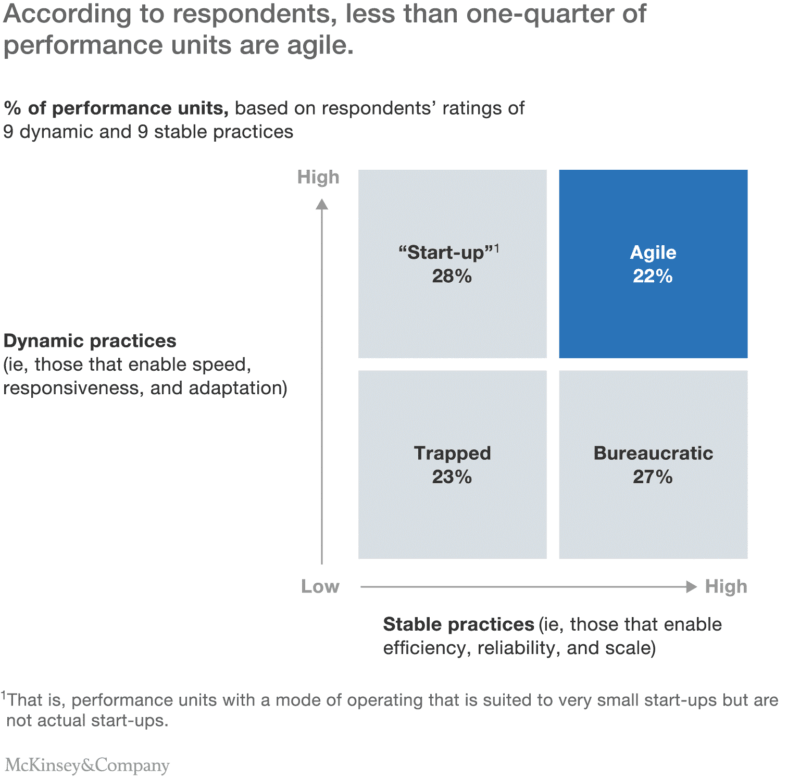
Although nearly every organization on earth is vying to increase its agility, not all are achieving that goal. In fact, according to a recent McKinsey Global Survey, organizational agility, which the firm defines as, “The ability to quickly reconfigure strategy, structure, processes, people, and technology toward value-creating and value-protecting opportunities,” is still elusive for most.
Only 4% of all respondents say their companies have fully implemented a Lean-Agile transformation, though another 37% say that company-wide transformations are in progress in their organizations.
The exciting news is, Agile performance units are seeing results: 81% of respondents in Agile units reported a moderate or significant increase in overall performance since their transformations began.
On average, respondents in Agile units are 1.5x more likely than others to report financial outperformance relative to peers, and 1.7x more likely to report outperforming their peers on nonfinancial measures.
It’s obvious that undergoing an Agile transformation is a worthwhile pursuit for most organizations—but how exactly do organizations become Agile, and what practices sustain the methodology?
Underlying any successful Agile transformation are two balanced forces: stability and dynamism. According to McKinsey:
“Dynamic practices enable companies to respond nimbly and quickly to new challenges and opportunities, while stable practices cultivate reliability and efficiency by establishing a backbone of elements that don’t need to change frequently.“
Together, these two forces enable agility at scale.
The following 18 practices are what McKinsey analysts consider to be critical for organizational agility—they are an even balance of stability- and dynamism-promoting practices. They include:
Dynamism:
- Actionable strategic guidance
- Sensing and seizing opportunities
- Flexible resource allocation
- Action-oriented decision architecture
- Fit-for-purpose accountable cells
- Active partnerships and ecosystem
- Rapid iteration and experimentation
- Open physical and virtual environment
- Performance orientation
- Shared vision and purpose
- Standardized ways of working
- Information transparency
- Continuous learning
- Cohesive community
- Entrepreneurial drive
- Role mobility
- Technology, systems, and tools
Stability:
Teams or organizations struggling to achieve agility are likely to be underperforming in either dynamism or stability, or both.
BECOMING AGILE
The path towards agility for any organization depends on its starting point. The first step is to determine exactly where you’re out of balance—from there, you can uncover specific, targeted practices to help you achieve true agility. Going through the list above can serve as a helpful exercise for anyone looking for actionable ways to improve their team or organizational agility.

HIGH DYNAMISM, LOW STABILITY: STARTUP
If your organization’s Agile transformation is high on dynamism, but low on stability, you’re in startup mode. Startup units are characterized as operating ad hoc – constantly shifting focus, while being unpredictable and disorganized. They also often lack the discipline and systematic execution to sustain reliable operations.
Units in startup mode should focus on fostering better stability practices, while expanding the use of their dynamic practices related to process and strategy to maintain agility and speed. Incorporating the stability practices above can help to bring efficiency, reliability, and scalability.
LOW STABILITY, LOW DYNAMISM: TRAPPED
Is your organization suffering from both low stability and low dynamism? Run! Okay, maybe not – but this is not a quadrant that any organization should hope to remain in for too long. McKinsey refers to units in this quadrant as Trapped. They lack both a stable backbone to maintain order and the dynamism to evolve or grow.
When it comes to stability practices, Trapped units often struggle most with people problems – only 13% of Trapped respondents say they follow shared and servant leadership, compared to 89% of their Agile peers. Trapped units also fall far behind Agile organizations in terms of actionable strategic guidance (daily work is tied closely to organizational initiatives), performance orientation (team members work to achieve defined metrics and performance indicators), and community cohesion (trust and accountability across the organization).
The dynamic practices in which they are furthest behind are process-related, especially continuous learning and rapid iteration and experimentation. Trapped organizations should focus first on creating stability and a healthy culture before diving too deeply into expanding dynamic capabilities.
HIGH STABILITY, LOW DYNAMISM: BUREAUCRATIC
If your organization is a little too hooked on stability – i.e. in bureaucratic mode – you need to focus on developing your dynamic practices and modifying your stable backbones, especially on practices related to people, process, and structure.
In the McKinsey survey, bureaucratic implementations suffered most when it came to rapid iteration and experimentation; technology, systems, and tools; continuous learning; and sensing and seizing opportunities. In fact, only 29% of bureaucratic respondents said they practiced rapid iteration and experimentation, compared to 81% of Agile respondents. These respondents are also considerably less likely to use MVPs (minimum viable product) to test their ideas (just 19% compared to 74% of Agile respondents).
Creating space for these practices can enable the speed, responsiveness, and flexibility organizations need to compete with their more Agile counterparts.
Bureaucratic organizations should also investigate ways to leverage and build upon their existing stability, specifically when it comes to people – such as by embracing performance orientation; shared and servant leadership; incentivizing team-oriented behavior; and investing in employee development. These practices can foster autonomy, creativity, and collaboration in ways not commonly seen in bureaucratic environments.
CONCLUSION
Looking for more practical tips for how to become Agile? Read this article on Agile best practices for teams, or check out the Lean-Agile Delivery section of our Resource Center!

![A Global Collaborative Work Management Blueprint [Video]](https://blog.planview.com/wp-content/uploads/2019/07/A-Global-Collaborative-Work-management-blueprint.png)


